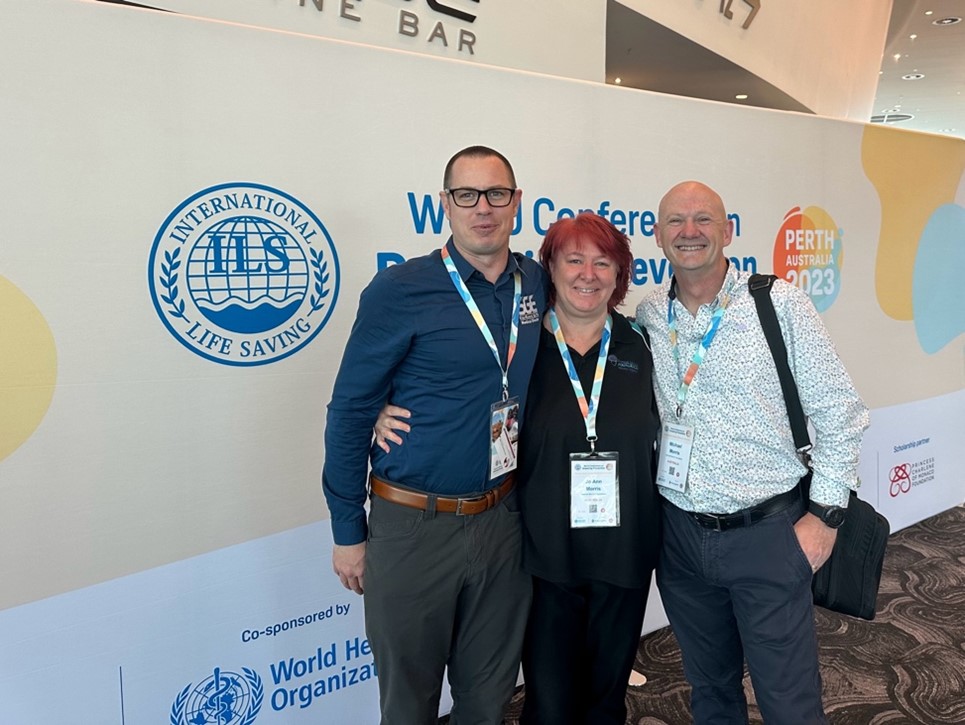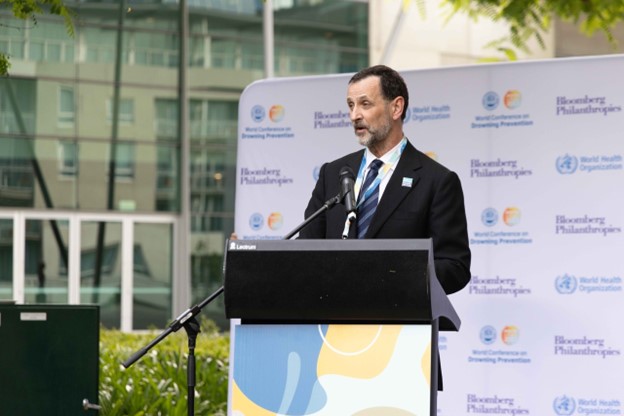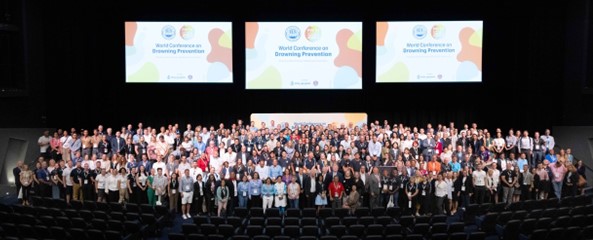We’ve just returned from the World Conference on Drowning Prevention (WCDP) in Perth, Western Australia. The WCDP is the Super Bowl and World Cup of the drowning prevention, rescue, and treatment communities. The first conference was convened in Amsterdam in 2002 by the Dutch lifeguard-turned-anesthesiologist, Dr. Joost Bierens. This initial meeting of world experts produced the first consensus guidelines for the treatment of drowning and identified major areas of disconnect in our understanding of the problem, including a lack of uniform definitions and reporting. This group was the first to emphasize the importance of prevention and rescue in reducing the burden of drowning rather than just advances in treatment, and critically, that drowning was a process, not an outcome. They also formally defined drowning as "the process of experiencing respiratory impairment from submersion/immersion in liquid.”

The author, JS, with Michael and Jo Ann Morris of the Samuel Morris Foundation, who work to prevent drowning and support non-fatal drowning survivors. (WCDP 2023)
This initial endeavor was followed by conferences in 2007, 2011, 2013 (when Will and I first met), and now occurs every two years. The 2021 conference was skipped due to the COVID-19 pandemic, so this was the first time many of us have been together since Durban, South Africa in 2019 and much has changed in the world since. We’re excited to share some of our takeaways from this most recent conference.
WCDP 2023 was convened under the banner: shaping global strategy, mobilizing for local action. This meeting was the first global drowning prevention conference since the United Nations General Assembly and the World Health Assembly passed resolutions related to drowning prevention. These resolutions call for several actions to advance drowning prevention around the world:
Several major themes in the conference were derivatives of various components of these resolutions, which already serve as important catalysts for action at global and local levels.

Dr. David Meddings, World Health Organization Director at the Department for Management of Noncommunicable Diseases, Disability, Violence and Injury Prevention during a welcome reception. (WCDP 2023)
The conference included over 350 presentations in all matters related to drowning prevention, rescue, and treatment. The WCDP 2023 Conference Closing Statement was recently released, and includes a brief overview of various talks, workshops, and discussions of the major conference themes: advocacy, leisure management, policy, prevention, rescue, research, swimming and water safety education, and medical aspects of drowning. The statement also includes 17 calls to action that were co-developed by the attendees throughout the conference under the themes of shaping global strategy and mobilizing for local action.
With so much content from so many passionate and intelligent drowning prevention colleagues, we could spend the next sixteen issues of this magazine discussing our favorite parts. Instead, we’ve endeavored to highlight a few of our big takeaways. These are the hot topics we’ve been discussing with each other and our various drowning prevention networks since leaving Perth and wanted to share with the WMS community:
Equity
With more than 90% of the world's reported drowning deaths occurring in low- and middle-income countries, it is critical that those most affected have their voices heard. Global prevention, rescue, and treatment programs must provide a meaningful impact in the communities most at risk. A recurring theme was “nothing about us without us”. One great example is the story of water safety programs in indigenous Māori communities, as featured in the most recent post in Dispatches. Another presentation that blew the conference attendees away (us included) was by Dr. Masaki Shibata from the University of Adelaide, who showed that English language beach safety signage translated into Japanese or Chinese with Google Translate was not reliable or accurate, and that international students and other visitors could misunderstand colloquial terms like “shore dump” frequently used by Australian’s lifeguards and the beach safety community.
Climate Change
Climate change is an under-appreciated threat multiplier for drowning. Hotter temperatures drive increased interaction with water in both high- and low-income settings as people seek places to cool off, and place rescuers at higher risk for heat-related illnesses. Increased flooding and severe weather events increase the call for the trained and coordinated response of bystander surfers, boaters, and lifeguards before, during, and after major disasters. Droughts put pressure on piped water systems forcing people to wash and bathe in open water settings (e.g., ponds) and causes people to store fresh water in the home, often in uncovered containers which pose a drowning risk to small children. Forced displacements, which can be exacerbated by natural disasters and a warming world, are at an all-time high. Data can be difficult to obtain, but drowning risks are high as migrants are increasingly forced into unsafe interactions crossing bodies of water.

Associate Professor Jagnoor Jagnoor, from The George Institute for Global Health, highlighted during the panel discussion on drowning risk and climate change. (WCDP 2023)
Youth
While we hate to admit it, both of us had the realization that we’re no longer the young ones in the group. Drowning is a preventable injury that disproportionately affects the younger generation, so it makes sense that we need to engage them in developing solutions. There are some impressive young people in this space and we must amplify youth voices to better guide messaging, understand their needs, and ensure that they have the tools they need to carry the community to the next level. We must abandon the paternalistic, top-down paradigm.
Treatment
On the medical treatment of drowning, there is a working group of authors who did scoping and systematic reviews on several topics related to drowning that made their way into the 2022 and 2023 American Heart Association guidelines. The 2023 guidelines emphasized that lifeguards are professional rescuers with a duty to respond. Since the morbidity and mortality of drowning is driven by cerebral hypoxia, it’s no surprise that the treatment is getting oxygen to the brain as early as possible, even if on a boat or still in the water. Looking ahead past the initial treatment, this year’s WCDP highlighted that the treatment of drowning is more than just the initial resuscitation. In addition to studies on Post-traumatic Stress Disorder in a drowning survivor and the lasting traumatic impact of surviving a rip current incident, there were several abstracts on the additive mental health injury to professional rescuers and lifeguards as a result of repeated exposure to microtrauma. Our prediction (and hope) is that future drowning treatment guidelines will extend to the short- and long-term mental health of both the rescuers and the patients.
In closing, the world around us is changing and rapidly evolving. The drowning prevention, rescue, and treatment community is no exception and is evolving in exciting ways. We must continue to adapt to stay relevant and sustain efforts that work towards the goal of zero drowning fatalities. The WCDP continues to be a diverse think tank that brings together the many different voices and niches of those who seek to reduce the global burden of drowning. We know there is a lot of homework to do as we seek to engage with communities outside of our own. All aspects of drowning require multisectoral engagement. No one agency, organization, or sector “owns” drowning prevention; the issue is too big and too complex for any one profession or specialty to solve the problem. At the end of the day, we need each other… Stay safe out there!

WCDP 2023 Delegates (WCDP 2023)